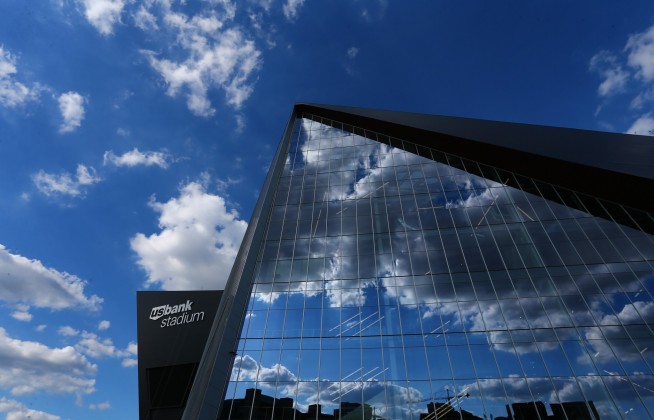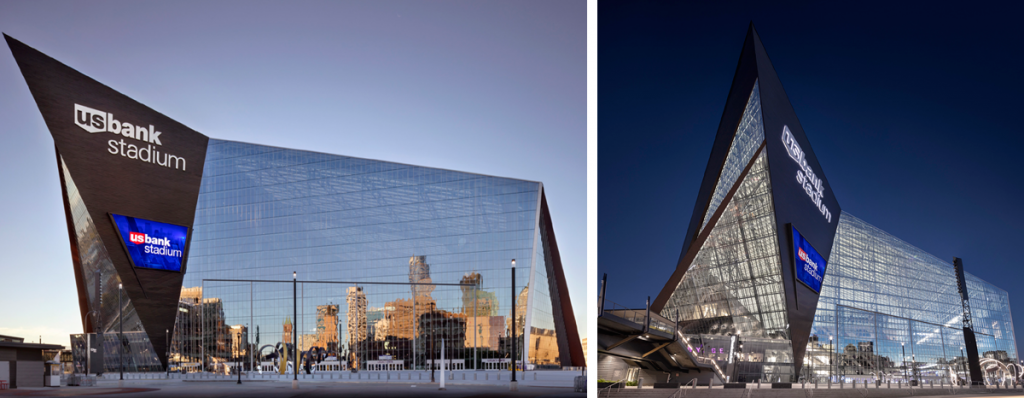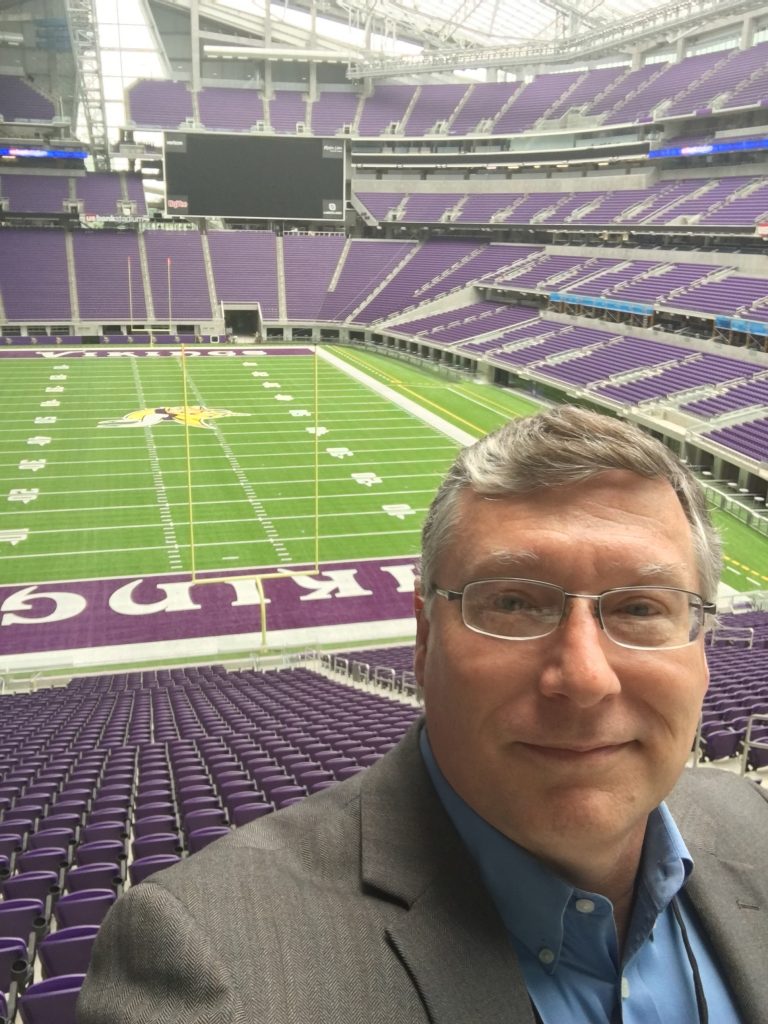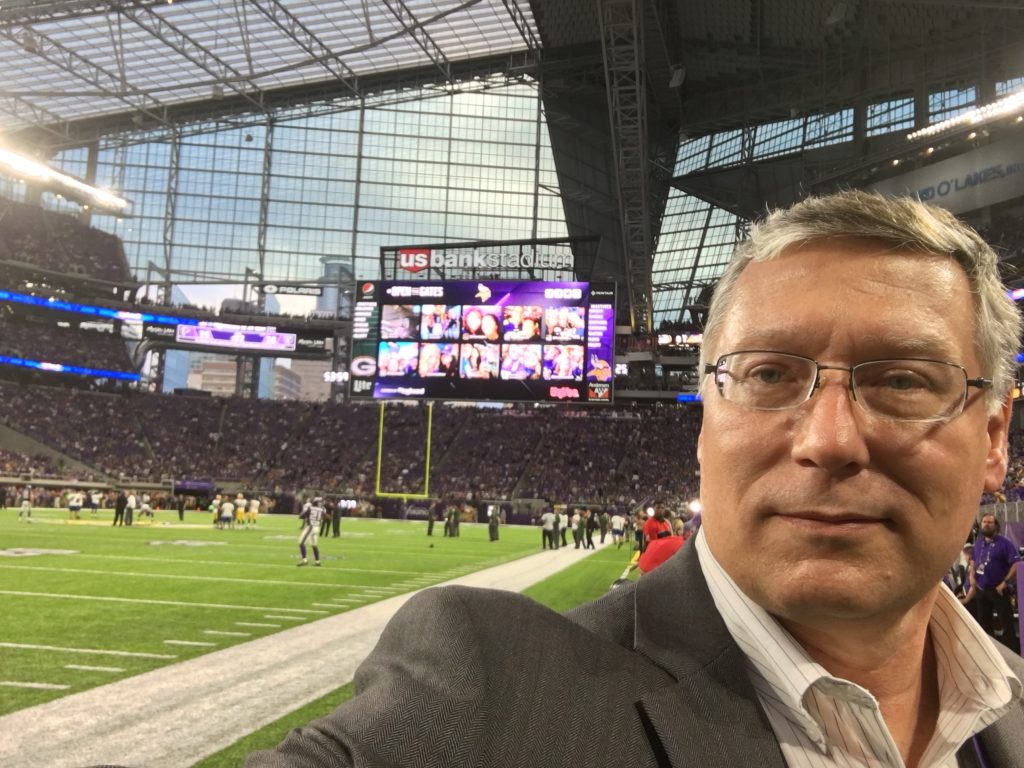- March 27, 2017
- Posted by: SportsV
- Categories: Features, Home News, Industry News, Interviews, News
No Comments

Katie McIntyre discusses the Minnesota Vikings new U.S. Bank Stadium together with the latest in venue technology and sports IT with Tod Caflisch, the team’s VP & CTO.
Firstly, can you tell us a little about you, your career path thus far, including career highlights, and your aspirations for the future?
I just completed my 27th sports season working in sports IT. I’ve had a great run in a career path that has taken me all over the place and given me the opportunity to meet and work with some great people. Out of graduate school I worked a few years supporting technical corporate projects for IBM, EDS and Clarke American which led me to San Antonio. Though I was not really looking for a job in sports, through networking I found out about an IT position the San Antonio Spurs were looking to fill that involved experience I already had. The Spurs hired me as their Computer Resource Manager, which I did for a few years before being promoted to Director of IT in the summer of 1999, when the Spurs won their first NBA championship. Shortly afterward, the organization started planning on the construction of the SBC Center (now AT&T Center). It was then that I experienced another great opportunity in the planning and construction of the technical elements of the new arena that we opened in the summer of 2002, along with a new state-of-the-art practice facility for the Spurs.That first year at the AT&T Center we also launched an AHL franchise (Rampage) and WNBA franchise (Stars), as well as took on venue operations, another first for the organization and myself. We ended up winning 3 more NBA Championships over the next 5 years.In 2007, the New Orleans Hornets were returning to New Orleans after 2 seasons in Oklahoma City due to Hurricane Katrina and were looking for an experienced sports IT leader. This was an another ideal opportunity and challenge for me to build the organizations IT department and infrastructure up from scratch as I had done in San Antonio, so I spent the next 5 years doing that, during which we hosted the 2008 NBA All-Star Weekend.From there I spent a season in Memphis with the Grizzlies where I got to run an arena again (FedEx Forum) until the opportunity arose to join the Detroit Red Wings. Additionally, I lead technology at Joe Louis Arena and spearheaded Olympia Entertainment’s technology efforts for the new Little Caesars Arena and District Detroit projects. While leading those projects I also deployed Extreme Networks high density Wi-Fi and Micros point of sale solutions at the Joe Louis Arena for the first time.In the summer of 2016, I received a call about my interest in the newly created VP & CTO role for the Minnesota Vikings. As working in an NFL franchise in an IT leadership role had been a long time career goal I was fascinated with the opportunity. It included opening the newly constructed U.S. Bank Stadium and leading the technology development for the Vikings’ new practice facility and mixed-use development, which would highlight the launching of the Vikings’ new WISE program, a sports technology innovation centre as a startup incubator/accelerator.
As VP & CTO for the Minnesota Vikings – who moved into their new home just a matter of months ago – what would a regular working week entail and how do you overcome challenges?
There are challenges whenever a new venue is opened, so having a systematic approach to the “shakedown cruise” is essential.Opening as large a new building as the U.S. Bank Stadium requires a lot of different groups communicating well to begin with, so a structured series of meetings helps to keep everyone up-to-date and expose real and potential issues.A typical week would involve a few meetings with stadium related constituents, as well as Vikings internal meetings on operations. As NFL teams have much fewer games than the NBA, NHL or MLB, it’s important that they all go off perfectly from a fan experience perspective to maximize impact and revenue opportunities.
Technology is obviously extremely important to the Minnesota Vikings and your brand new state-of-the-art U.S. Bank Stadium. What kinds of fan experience and fan engagement technologies, services and solutions do you employ in the new stadium?
There was an extreme focus on fan experience, starting with our VenueNext app. The app has everything from ticketing and wayfinding to food ordering and video replays. We deployed self-scan kiosks at our entries for both digital and printed tickets, which was supported by the high density operational and fan facing Wi-Fi throughout the stadium. There is also high density DAS coverage that includes Verizon, AT&T and T-Mobile carriers and Sprint will be on board soon.There is also a content rich IPTV system throughout the stadium to keep our fans up-to-date on current on-field action, other game scores, upcoming events and general stadium information.One of the other areas that’s a bit of a hidden gem at the stadium is the Vikings Voyage. This space is dedicated to Vikings football history, as well as an immersive interactive environment where fans can experience what it’s like to be a Vikings player via virtual reality, as well as compete with fellow fans through activities tracked through wearable technology.
What other kinds of technology are being implemented both at the stadium and practice facility in terms of venue management, operation, etc? And are there any specific challenges when it comes to running a multi-purpose venue like U.S. Bank Stadium, which is not only home to the Vikings but also host to concerts, family shows, college & high school sporting events, conventions, trade shows, etc.?
We are looking to partner with Verizon for smart city technology at our practice facility and surrounding mixed-use development.The smart city tech includes directional digital signage for general and event information, Wi-Fi/DAS, intelligent street lights and traffic lights and security systems.Verizon deployed some smart city tech at this year’s Super Bowl, so my expectation is they will also look to the Vikings to implement certain smart city elements around the stadium this coming season and for the Super Bowl. The advantages of smart city technology range from better security and fan experience to significant cost savings in energy.

You joined the Vikings just prior to the launch of the U.S. Bank Stadium, in June of last year, and were tasked with leading the technical efforts in the successful launch of the new stadium, as well as leading the design and implementation of the new Vikings practice facility and mixed-use development projects. Can you give us some insights as to how you planned out what was needed and delivered on these objectives? And is everything working as expected?
It would be impossible for me to take any credit for how incredible the stadium turned out, as I showed up in time to open the doors. I did however follow the project very closely from its inception as I was in a similar process in Detroit at the time with the Red Wings working on the technology plans for the Little Caesars Arena and District Detroit projects. I was working with CenturyLink there who was a key partner in the technology implementation for the stadium and visited the Twin Cities a couple times to tour the facility under construction. I did have experience though in opening a new venue when we opened the AT&T Center while I was with the San Antonio Spurs.A lot of the successful launch goes back to my previous answer about organized, regular meetings of all of the stakeholders, as there are a lot of moving parts in operating a sports/entertainment venue. My IT team and I attended a soccer game and concert at the stadium to get a better feel for how ingress and egress flowed, especially around our ticket scanning kiosks. We also observed crowd flow, concessions, IPTV and monitored Wi-Fi to ensure coverage and proper bandwidth. It also gave us the opportunity to cross train a bit in advance of the Vikings preseason starting.Of course, there was also a lot of system testing leading up to the season as well. As far as everything working as expected, I’d say yes, as feedback from fans regarding their experiences have been pretty positive.
As a techno whiz, who’s been in the sector for many years, which have been the biggest and most important technological advances in the sports venue industry and why?
Ha! Techno Whiz … should I be wearing one of those hats with the propeller on the top? As far as “biggest and most important technological advances in the sports venue industry” I’d have to say the advancement of high density Wi-Fi and DAS at venues.As the smart phone has become such a part of everyone’s life, it’s only normal to assume that it would also play a big part in how people entertain themselves. By having high density coverage it lays the foundation for so many things you can do through a fan’s smart phone and apps. And we’re just scratching the surface right now. Smart phones also allow the teams to maintain relevant touchpoints with their fans during the off season as well.

As the host venue for the 2017 and 2018 Summer X Games, the Super Bowl LII (2018) and the NCAA men’s final four, will there any kind of specific challenges that will need to be addressed?
Hopefully the Vikings will be playing in Super Bowl LII, so they’ll be welcome challenges. But generally for all of those events I’d say parking, of all things, may be the biggest challenge. There is limited space adjacent to the stadium and controlled by a variety of owners. This is a specific problem I’d really like to throw a lot of energy behind as parking is generally one of the most highly criticized elements of events through post season surveys and can heavily impact fan experience.
What kinds of technology can visitors to the stadium’s 131 suites expect to enjoy?
We’re looking at some really fascinating new tech this off season as ways to improve our suite fan experience. I can’t go into details here as there are some key partnerships in the works but I can share that smart device charging and voice activation are potential upgrades.
We shall certainly look forward to hearing back from post the off season, when you will be able to share details with our readers about these potential upgrades. In the meantime, in regards to the next 2-5 years, what kinds of technological evolutions do you foresee?
Looking ahead, I see virtual and augmented reality growing immensely in all areas of venue integration. The obvious ones are enhancing the fan experience from an entertainment perspective but there are also opportunities in the way that venues operate and serve the fans. I also see wearable technology growing from a fan, operations and player perspective. There is a lot of value in the enriched fan experience (think Disney’s “Magic Bands”) but also in the benefits of improved operations and a deeper understanding of player and team performance data and analytics. I also believe once the technology settles a bit and more standards take hold that IoT will become a huge part of daily life, including entertainment.
Finally, are their any planned future developments or items on your wish-list?
As I just bought a new home in the Twin Cities recently, I’ve been experimenting a lot with different IoT related technologies – voice activation, lighting, security, etc. There is nothing but upside for these types of vendors and applications in the sports and entertainment vertical. It’s still a little bit of the wild west out there with IoT though as security is a concern. Once that issue is resolved and standards settle a little there will be an explosion of deployment.Part of our new mixed-use development around our new practice facility will include residential property. My plans are to include as much IoT as possible in that development, as it will dovetail well with our innovation efforts through our WISE program. But there will also be practical applications at our practice facility and at the U.S. Bank Stadium as well.

Huge thanks to Tod Caflisch, VP & CTO, Minnesota Vikings Football, LLC, for taking the time out of his busy schedule to do this interview.
Main image of the U.S. Bank Stadium (top), courtesy: HKS Sport + Entertainment

